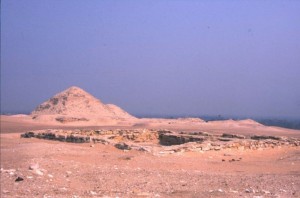 The tomb of Udjahorresnet is the westernmost of the tombs in this group and also lies on the highest located spot, and it is probably the first tomb to have been built in this part of the cemetery. The superstructure is formed by a massive enclosure wall made of local limestone, originally cased by smaller blocks of white limestone. In the centre of the enclosure, over the mouth of the main shaft, the remains of a structure, that probably originally had the shape of the sacred primaeval hill, were preserved – a square structure with inclined walls and flat roof.
The tomb of Udjahorresnet is the westernmost of the tombs in this group and also lies on the highest located spot, and it is probably the first tomb to have been built in this part of the cemetery. The superstructure is formed by a massive enclosure wall made of local limestone, originally cased by smaller blocks of white limestone. In the centre of the enclosure, over the mouth of the main shaft, the remains of a structure, that probably originally had the shape of the sacred primaeval hill, were preserved – a square structure with inclined walls and flat roof.
The substructure of the tomb is formed by the square main shaft with the sides measuring 5.5 m. At its bottom, slightly less than 20 m deep, there is a vaulted east-west oriented burial chamber, built of large blocks of white limestone. The walls of the chamber tightly enclose the large double sarcophagus, the outer made of two blocks of white limestone 5.1 m long, 2.75 m wide and 3.2 m high (the lid itself is 1.1 m thick). Inside, a basalt anthropoid sarcophagus is located. While the outer sarcophagus bears a single line of hieroglyphic text, the inner one is, in accord with the customs of the period, decorated with religious texts and depictions of protective deities. Sections of the Pyramid Texts, painted but never finished in relief, decorate also the walls of the burial chamber. The burial chamber was accessible by a small shaft, lying to the east of the enclosure, and a horizontal corridor leading from its bottom. The main shaft is on all four sides lined by a narrow deep ditch, which was probably intended above all to enhance protection against robbers.
The tomb was probably looted several times already in antiquity, so that only a few ushabti, a faience model of an offering table and a few fragments of the so-called magical bricks were preserved from the burial equipment. A unique discovery was made here in the form of the so-called foundation deposits of pottery and models of building blocks of various materials,
found under the corners of the enclosure wall. The sarcophagus was discovered completely empty, and so it is according to some scholars uncertain, whether the tomb owner was indeed ever buried here.
According to the texts, the tomb belonged to the chief physician of Upper and Lower Egypt Udjahorresnet, an important historical figure from the time of the first Persian invasion of Egypt, sometimes dubbed as “traitor” or “collaborator”. His famous statue, the most complete Egyptian source on the history of that period, is deposited in the Vatican museum.
Cf. also:
• L. Bareš, The Shaft Tomb of Udjahorresnet at Abusir. With a chapter on pottery by Květa Smoláriková and an appendix by Eugen Strouhal, Prague 1999
• M. Verner, „The Traitor´s Tomb?“, in: Abusir – Realm of Osiris, Cairo 2003, str. 177-191